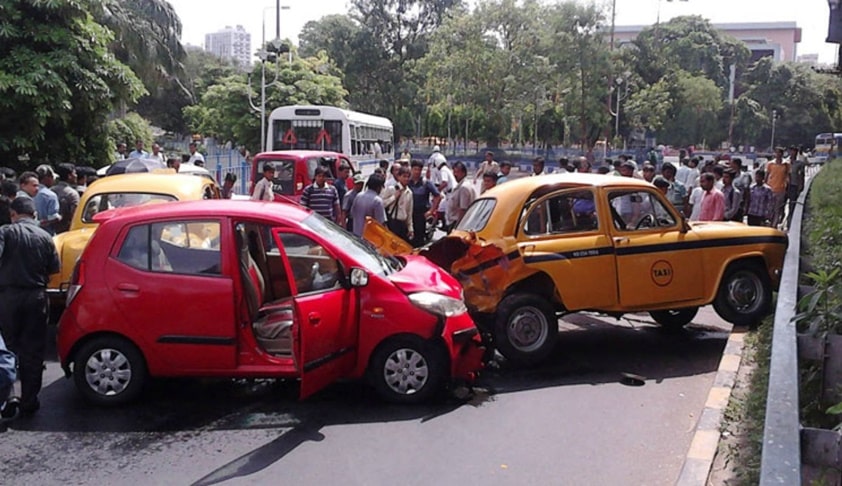
With over 1.5 lakh deaths annually in motor accident cases in India (as per the latest official records), it is not unsurprising that claims on account of compensation for motor accident deaths is one of the most disputed arenas of litigation in the Supreme Court. Time and again the Apex court has attempted to lay down a rule of thumb to grant compensation to ensure that...
With over 1.5 lakh deaths annually in motor accident cases in India (as per the latest official records), it is not unsurprising that claims on account of compensation for motor accident deaths is one of the most disputed arenas of litigation in the Supreme Court. Time and again the Apex court has attempted to lay down a rule of thumb to grant compensation to ensure that there is consistency and predictability in the compensation that is granted in motor accident related claims.
The need for consistency and predictability in motor accident related claims was highlighted in Sarla Verma v. Delhi Transport Corporation & Anr ("Sarla Verma") wherein it was held:
"While it may not be possible to have mathematical precision or identical awards, in assessing compensation, same or similar facts should lead to awards in the same range. When the factors/inputs are the same, and the formula/legal principles are the same, consistency and uniformity, and not divergence and freakiness, should be the result of adjudication to arrive at just compensation."(¶8)
Compensation awarded does not become 'just compensation' under the Motor Vehicles Act, 1988 ["MV Act"], merely because one Motor Accident Claims Tribunal ["MACT"] considers it to be just – there should be uniformity across all MACT in coming down to a similar formulation of compensation. Both §140 and §163-A allow compensation on a no-fault liability basis. The former provides for interim relief whereas the latter is a final one (¶¶43-45). As per §163-B, a claimant can file a claim under any one of the sections but not both. Introduction of §163-A was a shift from the fault-liability regime that existed previously since the requirement of proving fault of the owner of the motor vehicle was done away with (¶41). However, courts found that the method of compensation through a structured compensation method provided for in Schedule II of the Act was riddled with inconsistencies and defects. To make more effective this grant of compensation, courts evolved their own formula for grant of compensation.
Since the formulas evolved are only guidelines for compensation, in the absence of statutory and a straitjacket formula, there are bound to be grey areas. Nonetheless, the author here surmises the broad principles that have been formulated in granting compensation for fatal accidents and paints a picture of the grey areas that emerge when such questions arise before the Court. The author also argues that the 2018 Amendment to the Schedule II of the Act providing for fixed compensation instead of the structured formula method evolved by the Courts is faulty. Accordingly, statutory changes must be made to reflect the method evolved by the judiciary to ensure uniformity in application of the guidelines.
Judicial Dicta evolved on the Principles for Assessing Compensation
The compensation is given by assessing the following heads:
- Loss of dependency;
- Loss of consortium, loss of estate and funeral expenses; and
- Contributory Negligence (if any).
The parameters of calculating the same are delineated below.
- Loss of Dependency
In Sarla Verma, it was laid down that the important factors to be considered a) age of the deceased at the time of death; b) his income at the time of death; and c) the number of dependants left behind. To adequately take into account all these factors in calculating loss of dependency, the following methodology was adopted: (Actual Income of the deceased per annum - Personal and living expenses of the deceased + Future Prospects) x Multiplier.
The actual income is based on income less tax if the income comes within the taxable bracket. Here computation of notional income is also done in special cases such as those of housewives. It was held in Lata Wadhwa v. State of Bihar that considering the multifarious services rendered by housewives, their notional income for the age group of 34 to 59 years should be INR 36,000/- per annum for the purposes of computing compensation. For elderly ladies aged 62 to 72 years, value would be taken at INR 20,000/- per annum. In Arun Kumar Agrawal v. National Insurance Co. Ltd., the MACT gave notional income of INR 5,000/- per month to the housewife and the Supreme Court held that the amount payable to dependents could not be diminished on the grounds that a close relative could volunteer for the services provided by the deceased (¶27).
Following this, the Supreme Court in the recent June 2020 case of Rajendra Singh v. National Insurance Co. Ltd. held that income of the housewife would be computed at INR 5,000/- per month and an amount of 40% would also be granted towards future prospects (¶11). On the question of whether pension received by a widow who died in a motor vehicle accident would be computed in calculation of income, the Supreme Court in National Insurance Company Limited v. Birender and Ors. said it would not (¶21). In this case, it was also held that two grown sons of the deceased could be considered eligible for compensation under 'loss of dependency' under §166 of the MV Act.
The personal and living expenses depend on the deceased's marital status and the number of dependants he has. The Court does not look at evidence of actual personal expenses, but objectively computes the same. The following table shall be useful in computing the same and is ordinarily followed unless a cause for departure from the same is made out.[1]
| Marital Status | Number of dependant family members | Amount of income to be deducted towards personal and living expenses |
| Married | 2-3 | 1/3rd |
| Married | 4-6 | 1/4th |
| Married | >6 | 1/5th |
| Bachelor | Claimants are dependant parents:
| ½ |
| Bachelor | If Claimants are large in number owing to the large family of the deceased, say with a widowed mother and a number of younger non-earning brothers or sisters | 1/3rd |
An instance of cause of departure from the above principles is the United India Insurance Co. Ltd. v. Satinder Kaur @ Satwinder Kaur & Ors. case, wherein the deceased was a resident of a foreign country. The Apex Court held that while considering the case of the deceased ordinarily 1/4th of the income would be deducted towards personal expenses, in the instant case, being resident in a foreign country meant that higher living and other expenses would be there and hence, a deduction of 50% was justified (¶9.2).
Since the endeavour is to put dependants/claimants in the pre-accidental position, compensation also accounts for prospective pecuniary loss. National Insurance Co. Ltd. v. Pranay Sethi & Ors. ("Pranay Sethi") was a five-judge bench decision of the Supreme Court in which the principles governing calculation of future prospects were concretised, so that the increment in income could be adequately accounted for. Differentiating from Sarla Verma[2], it was held that merely because a person may be self-employed, did not mean that he would remain static in his career path. Such an assumption was against the "fundamental concept of human attitude which always intends to live with dynamism and move and change with the time" (¶59). Accordingly, it held that the actual income would be incremented with the following percentages in the determination of future prospects (¶59):
|
| Below 40 years | 40-50 years | 50-60 years |
| Deceased with a Permanent Job | 50% | 30% | 15% |
| Deceased self-employed or on a fixed salary | 40% | 25% | 10% |
Notably, for the death of minor children, there is a divided opinion in the Supreme Court when it comes to grant of just compensation while accounting for future prospects. In New India Assurance Co. Ltd. v. Satender, the victim was a 9 year old child. The Supreme Court held that considering the uncertainties that abound when it comes to small children, income and financial loss suffered by parents would be incapable of financial assessment (¶12). In 2009 however, in the case of R.K. Malik v. Kiran Pal, where the deceased was a 10 year old, stated that future prospects ought to be granted for children as well (¶33).
In one of the recent cases in the Supreme Court, the Division Bench chose to follow the aforementioned Satender case and refused to enhance compensation on the ground of future prospects (¶12-15). In the author's opinion, such a stance is problematic considering that if income can be assessed notionally for minors, there is no reason why future prospects should also not be adequately calculated.
The multiplicand arrived at by taking into account income and future prospects and deducting personal expenses is then multiplied with the multiplier. The multiplier was formulated taking into account the age of the deceased and the period of active career as well as the imponderables in life and various economic factors. Before the standardisation of the multiplier in Sarla Verma, there were different scales of multiplier followed by the Courts leading to inconsistencies. Sarla Verma clarified that the multiplier as shown below must be used as a basis (¶¶19-21). This has largely become the norm followed today in calculating the compensation.
| Age of the deceased (in years) | Multiplier |
| Upto 15 | - |
| 15 – 20 | 18 |
| 21 – 25 | 18 |
| 26 – 30 | 17 |
| 31 – 55 | 16 |
| 36 – 40 | 15 |
| 41 – 45 | 14 |
| 46 – 50 | 13 |
| 51 – 55 | 11 |
| 56 – 60 | 09 |
| 61 – 65 | 07 |
| Above 65 | 05 |
This is consistently followed irrespective of whether the deceased was a bachelor or married. The confusion that persisted earlier (from U.P. State Road Transport corporation v.Trilok Chandra) about whether the age of the parents of the deceased is to be considered was clarified by decisions such as Sarla Verma, Reshma Kumari, Munna Lal Jain and Pranay Sethi. It was held that only the age of the deceased is relevant for evaluating the applicable multiplier.
It may be noted that the age for calculating the multiplier as well as future prospects is taken in the same age group and not necessarily an exact age. In M.H. Uma Maheshwari & Ors. v. United India Insurance Co. Ltd. & Anr, the age of the deceased at the time of death was 50 years 3 months. The Supreme Court held that the High Court applying the bracket of 50-60 years to determine the future prospects and multiplier was erroneous and the general age group was required to be considered (¶8).
- Assessing the Three Conventional Heads
In Pranay Sethi it was held that in cases of death, compensation would be awarded only under the three conventional heads of loss of estate, loss of consortium and funeral expenses (¶54). These could not be determined on a percentage basis. They have to be quantified on a reasonable basis and the Constitution Bench held that the loss should be INR 15,000/-, INR 40,000/- and INR 15,000/- respectively enhanced by 10% every three years to ensure consistency.
Consortium was traditionally awarded only to the spouse, however, in Magma General Insurance Co. Ltd. v. Nanu Ram & Ors., this loss of consortium was determined to be a compendious term inclusive of spousal, parental as well as filial consortium. In United India Insurance Co. Ltd. v. Satinder Kaur @ Satwinder Kaur & Ors., the Supreme Court noted that there could be no justification for a separate head of loss of love and affection separate from the three conventional heads that Pranay Sethi had recognised.
- Contributory Negligence
The question of contributory negligence arises if both parties are involved in the accident due to rash and negligent driving. If there are instances of contributory negligence in causing an accident, the compensation amount arrived at by computing the above is reduced by a certain percentage depending upon the kind of contributory negligence. To lead to such a determination of contributory negligence however, a causal connection between the act of the victim and the causation of the accident or the act of the victim and the extent of injuries must be shown.
Where the accident took place while the deceased was overtaking another vehicle, the liability of contributory negligence was determined and a deduction of 50% was made from the amount of compensation determined. On the other hand, where the accident occurred with the deceased carrying more than one person on the pillion, it was held that the deceased could at most be guilty of violation of law, but not of contributory negligence (¶13).
Without wrongful act of the deceased contributing to the accident or the extent of injuries, no claim of contributory negligence could be justified. This wrongful act must be substantiated and not be a mere surmise. The standard of proof required to be followed in proving such acts of negligence is that of preponderance of probability and not the strict standard of proof beyond all reasonable doubt which is followed in criminal cases. If the deceased/claimants were wholly responsible for the accident, no claim of compensation under §166 of the MV Act would stand.
Conclusion
Thus, the final formula which emerges for calculating the compensation is:
| (Actual Income – Deduction towards personal Expenses + Future Prospects) x Multiplier |
While the principles governing "just compensation" cannot be calculated with arithmetic exactitude,[3] laying down a reasonable standard so that compensation may be fair and equitable across cases is important. Owing to the strict legislative formulation on the same, the judiciary stepped up and evolved a broad doctrine of computing compensation. Instead of statutorily recognising these principles, the 2018 Amendment to the Schedule II added a fixed compensation of INR 5 lakhs to be given in cases of death with annual increments of 5%. Additional compensation for the conventional heads were no longer provided explicitly, which is bound to lead to more confusion when the cases come before courts. Further, such an amendment does not reflect factors such as age, income and dependents of the victim and is insufficient to address the need of the situation.
The cases here are a clarion call that the legislature should formulate these guidelines into statutory provisions to ensure that the MACT applies these principles across cases uniformly and the burden of the apex court in adjudicating these cases is reduced. Such an amendment may be made by amending the Schedule II of the MV Act, laying down a clear cut formula as described above with clear heads to ensure that there is no contravention from the standards. At the same time, enough flexibility should be provided for cases which may be different from the norm so that the objective of a "just compensation" is not controverted in the quagmire of legal wording of the statute.(Author is a Xth Semester, B.A., LL.B. (Business Laws Hons) Student , at National Law University Jodhpur.)
[1] Sarla Verma, (2009) 6 SCC 121, ¶¶30-32, re-affirmed in Reshma Kumari & Ors. v. Madan Mohan & Anr, (2013) 9 SCC 65, ¶¶41-43.
[2] See also, Santosh Devi v. National Insurance Co.Ltd., (2012) 6 SCC 421.
[3] National Insurance Co. Ltd. v. Pranay Sethi, (2017) 16 SCC 680, ¶57.




